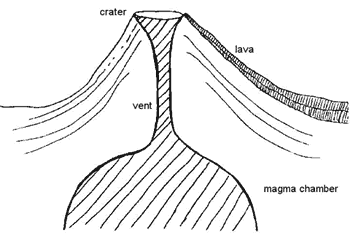BACKGROUND:
Volcanic eruptions are hazardous in several way, as
discussed in the Pre Lab. This lab emphasizes the effects of mudflows.
Mudflows are generated on the sides of volcanoes during and after eruptions.
Mudflows are a type of fluid landslide. They are composed of a mixture of
water (often melted snow or glacial ice), mud, rock, and other debris.
Mudflows vary in viscosity, which is a measurement of thickness or
stickiness. Highly viscous mudflows travel slowly, and may stop before
causing much damage. More viscous mudflows, which are often about as thick
as wet concrete, can flow rapidly and travel long distances. They are
dangerous, capable of covering people and animals and destroying structures.
Mudflow deposits often fill up stream channels, which causes flooding later
on.
Volcanoes have several basic components. Underneath
the volcano is a reservoir of magma (molten rock), called a magma chamber.
The magma chamber is connected to the surface of the Earth by a vent. The
magma moves upward through the vent because it is less dense than the
surrounding rock. It breaks through the surface of the Earth at the volcano’s
crater, and may flow down its side as a flow of lava, or an eruption of ash.
PROCEDURE:
In this lab the students simulate mudflows by making
mixtures of flour, sand or cornmeal, and water. They will try to determine
what type of viscous mixture would cause the most damage.
 Review and discuss the parts of a volcano. You may
wish to show the class the presentation image on the next page. Review
the hazards that volcanoes can cause, as discussed in the Pre Lab.
Discuss how population centers can influence the amount of damage that
is caused by a volcano. Do not forget to include in your discussion the
damage caused to wildlife, vegetation, and the environment. Review and discuss the parts of a volcano. You may
wish to show the class the presentation image on the next page. Review
the hazards that volcanoes can cause, as discussed in the Pre Lab.
Discuss how population centers can influence the amount of damage that
is caused by a volcano. Do not forget to include in your discussion the
damage caused to wildlife, vegetation, and the environment.
- Carefully demonstrate the lab procedures. You may
want to show the students examples of high and low viscosity mixtures.
Pour a few spoonfuls of the mixtures over a dome shaped object, such as
an overturned cup. We recommend putting the cup in a plastic tray, to
minimize the mess. Emphasize that in their experiments, the students
should keep track of the amount of materials that they are mixing. This
might be difficult for them, because they are usually given exact
amounts to mix. Explain that they have to learn to experiment.
- You may want to give them some hints as they are
doing the different trials. For example, they should think about the
quantities for each trial before they begin. This will help them improve
the mixtures, rather than just mixing random amounts every time. This
concept may also be new to them.
- Go over cleaning procedures. This can be a real fun
lab, but it can be very messy!
- In general, the more water in the mixture, the
faster it will move. Also, the less "ash" (i.e., flour in the
mixture) the faster it will flow.
|